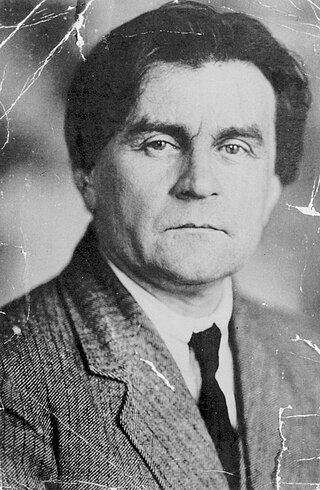
Kazimir Severinovich Malevich was a Russian avant-garde artist and art theorist, whose pioneering work and writing influenced the development of abstract art in the 20th century. He was born in Kiev, modern-day Ukraine, to an ethnic Polish family. His concept of Suprematism sought to develop a form of expression that moved as far as possible from the world of natural forms (objectivity) and subject matter in order to access "the supremacy of pure feeling" and spirituality. Active primarily in Russia, Malevich was a founder of the artists collective UNOVIS and his work has been variously associated with the Russian avant-garde and the Ukrainian avant-garde, and he was a central figure in the history of modern art in Central and Eastern Europe more broadly.

Moscow is the capital and largest city of Russia. The city stands on the Moskva River in Central Russia, with a population estimated at over 13 million residents within the city limits, over 19.1 million residents in the urban area, and over 21.5 million residents in its metropolitan area. The city covers an area of 2,511 square kilometers (970 sq mi), while the urban area covers 5,891 square kilometers (2,275 sq mi), and the metropolitan area covers over 26,000 square kilometers (10,000 sq mi). Moscow is among the world's largest cities, being the most populous city in its entirety in Europe, the largest urban and metropolitan area in Europe, and the largest city by land area on the European continent.

Red Square is one of the oldest and largest squares in Moscow, Russia. It is located in Moscow's historic centre, along the eastern walls of the Kremlin. It is the city's most prominent landmark, with famous buildings such as Saint Basil's Cathedral, Lenin's Mausoleum and the GUM department store. It has been a UNESCO World Heritage Site since 1990. Red Square has been the scene of executions, demonstrations, riots, parades, and speeches. Almost 73,000 square metres, it lies directly east of the Kremlin and north of the Moskva River. A moat that separated the square from the Kremlin was paved over in 1812.

Ivan III Vasilyevich, also known as Ivan the Great, was Grand Prince of Moscow and all Russia from 1462 until his death in 1505. Ivan served as the co-ruler and regent for his blind father Vasily II before he officially ascended the throne.

Kazan is the largest city and capital of Tatarstan, Russia. The city lies at the confluence of the Volga and the Kazanka Rivers, covering an area of 425.3 square kilometres, with a population of over 1.3 million residents, and up to nearly 2 million residents in the greater metropolitan area. Kazan is the fifth-largest city in Russia, being the most populous city on the Volga, as well as within the Volga Federal District.

Moscow State University (MSU), officially M. V. Lomonosov Moscow State University, is a public research university in Moscow, Russia. The university includes 15 research institutes, 43 faculties, more than 300 departments, and six branches. Alumni of the university include past leaders of the Soviet Union and other governments. As of 2019, 13 Nobel laureates, six Fields Medal winners, and one Turing Award winner were affiliated with the university.

The Moscow Kremlin or simply the Kremlin is a fortified complex in Moscow, Russia. Located in the centre of the country's capital city, it is the best known of the kremlins and includes five palaces, four cathedrals, and the enclosing Kremlin Wall along with the Kremlin towers. Within the complex is the Grand Kremlin Palace, which served as the royal residence of the Emperor of Russia. It is now the official residence of the President of the Russian Federation. The Kremlin overlooks the Moskva River to the south, Saint Basil's Cathedral and Red Square to the east, and Alexander Garden to the west.

Alexander Stepanovich Popov was a Russian physicist who was one of the first people to invent a radio receiving device.

The State Historical Museum of Russia is a museum of Russian history located between Red Square and Manege Square in Moscow. The museum's exhibitions range from relics of prehistoric tribes that lived in the territory of present-day Russia, to priceless artworks acquired by members of the Romanov dynasty. The total number of objects in the museum's collection numbers in the millions.

The Kremlin Wall Necropolis is the former national cemetery of the Soviet Union, located in Red Square in Moscow beside the Kremlin Wall. Burials there began in November 1917, when 240 pro-Bolsheviks who died during the Moscow Bolshevik Uprising were buried in mass graves. The improvised burial site gradually transformed into the centerpiece of military and civilian honor during the Second World War. It is centered on Lenin's Mausoleum, initially built in wood in 1924 and rebuilt in granite in 1929–30. After the last mass burial in Red Square in 1921, funerals there were usually conducted as state ceremonies and reserved as the final honor for highly venerated politicians, military leaders, cosmonauts, and scientists. In 1925–1927, burials in the ground were stopped; funerals were now conducted as burials of cremated ash in the Kremlin wall itself. Burials in the ground resumed with Mikhail Kalinin's funeral in 1946.

Tverskoy District is a district of Central Administrative Okrug of the federal city of Moscow, Russia. Population: 75,378 (2010 Census); 75,955 (2002 Census).

Manezhnaya is a pedestrian open space in the Tverskoy District, at the heart of Moscow. It is bound by the Hotel Moskva to the east, the State Historical Museum and the Alexander Garden to the south, the Moscow Manege to the west, and the 18th-century headquarters of the Moscow State University to the north.
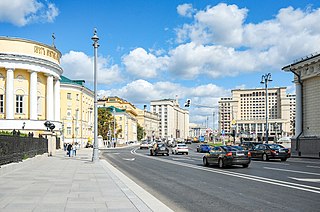
Mokhovaya Street is a one-way street in central Moscow, Russia, a part of Moscow's innermost ring road - Central Squares of Moscow. Between 1961 and 1990 it formed part of Karl Marx Avenue. The street runs from the Borovitskaya Square in the south past Vozdvizhenka Street, Bolshaya Nikitskaya Street and Manege Square, ending at Tverskaya Street in the north.

Universytet is a station on the Kharkiv Metro's Saltivska Line. The station was opened on 10 August 1984 and is located beneath the Maidan Svobody, at the time, the largest square in Europe and the second largest in the world after Tiananmen Square, in the centre of Kharkiv. The station is named after the Kharkiv National University, which is located on top of the square.
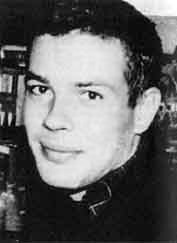
Vadim Nikolaevich Delaunay was a Soviet poet and dissident, who participated in the 1968 Red Square demonstration of protest against military suppression of the Prague Spring.
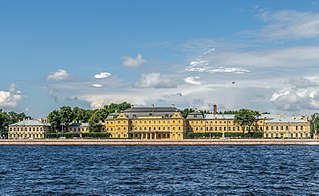
The Menshikov Palace is a Petrine Baroque edifice in Saint Petersburg, situated on Universitetskaya Embankment of the Bolshaya Neva on Vasilyevsky Island. Since 1981, it has served as a public museum, a branch of the Hermitage Museum.

Universitetskaya Embankment is a 1.2 km long embankment on the right bank of the Bolshaya Neva, on Vasilievsky Island in Saint Petersburg, Russia. Starting at the Spit of Vasilievsky Island, it spans between Palace Bridge and Blagoveshchensky Bridge.
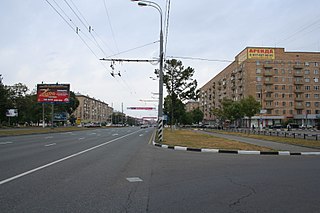
Lomonosovsky District, Moscow is an administrative district (raion) of South-Western Administrative Okrug, and one of the 125 raions of Moscow, Russia. The area of the district is 3.34 square kilometers (1.29 sq mi). Population: 85,000 . Population - 81,851. Established at 1995. Named after Mikhail Vasilyevich Lomonosov.

Quay with Sphinxes is a quay at the Universitetskaya Embankment in Saint Petersburg, in front of the Imperial Academy of Arts. It is remarkable for the two ancient sphinxes that were brought from Egypt to Russia at the height of Egyptomania in 1832. The quay was completed in 1834.

Saint Petersburg – second-largest city in Russia. An important Russian port on the Baltic Sea, it has the status of a federal subject. Its name was changed to "Petrograd" in 1914, then to "Leningrad" in 1924, and back to Saint Petersburg in 1991.




















